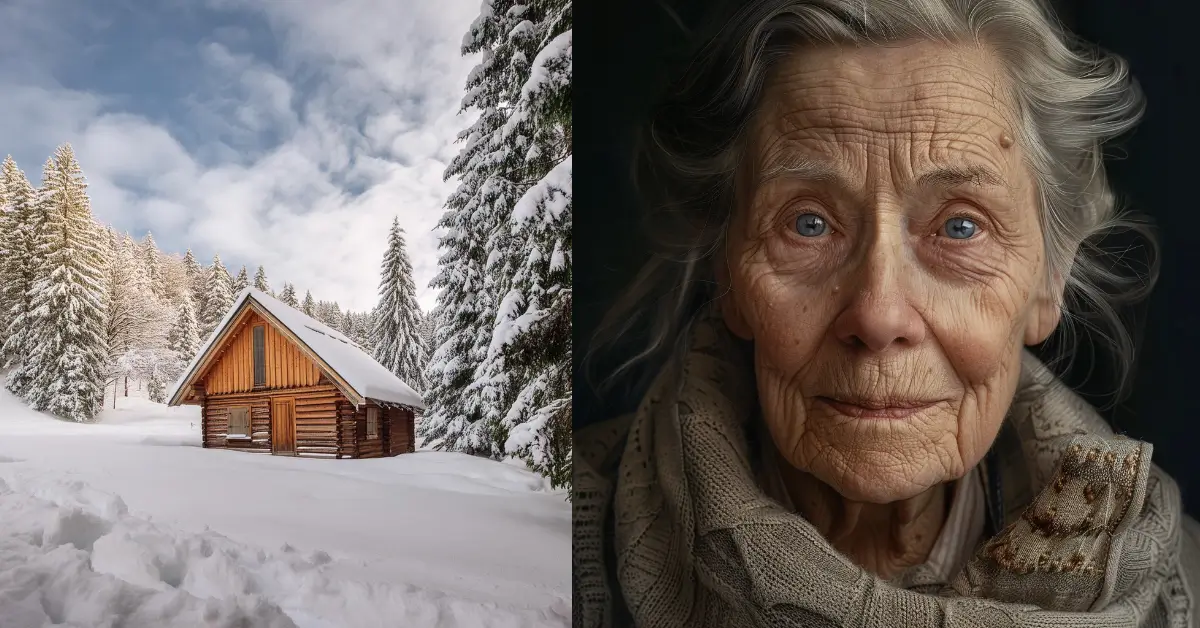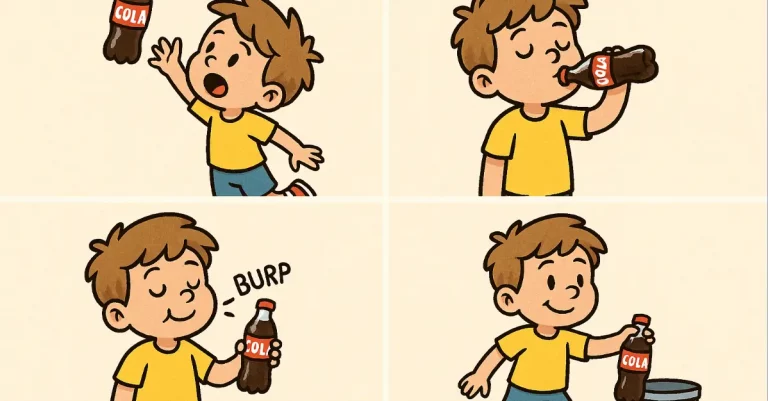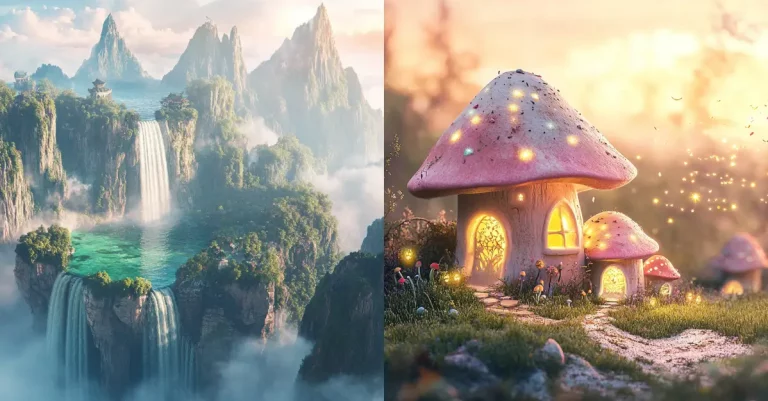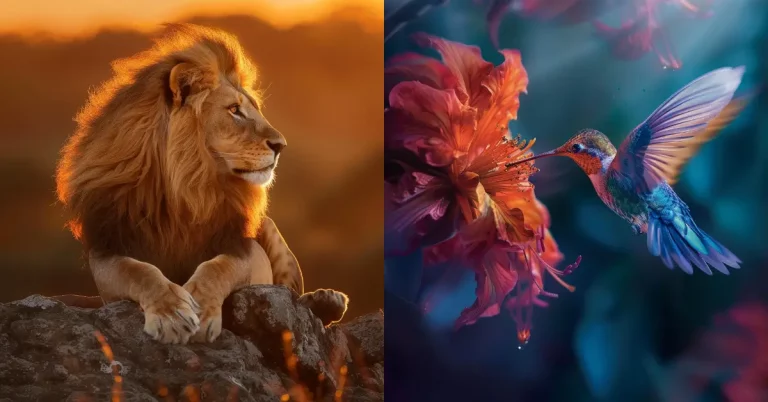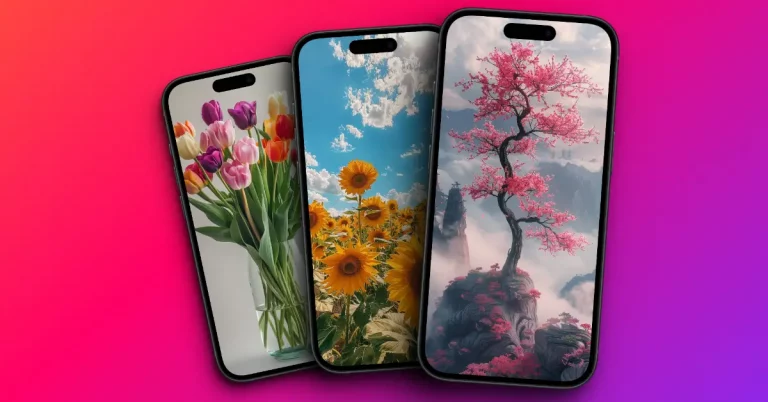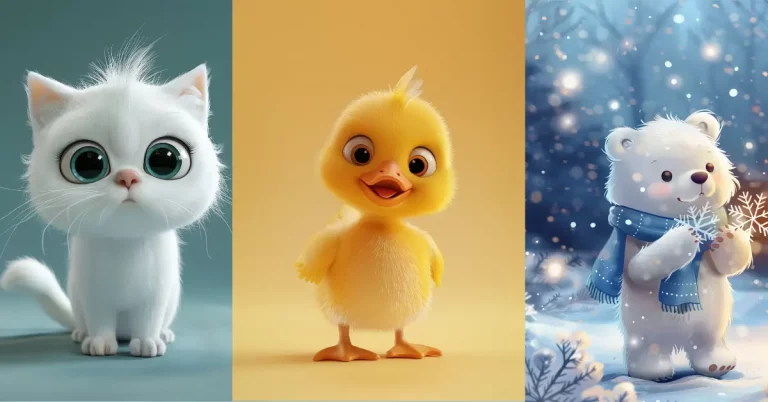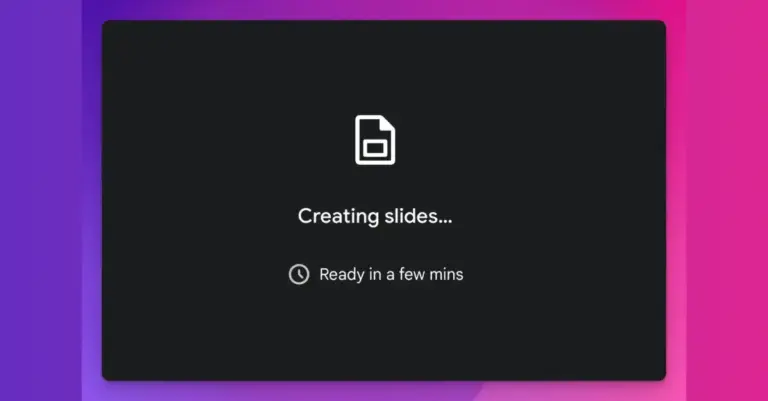Adobe Firefly 3 and Midjourney Version 6 Comparison Using 14 Prompts
Two notable players in AI image generation are Adobe Firefly and Midjourney, both of which have recently released new versions of their AI models. Adobe Firefly 3 and Midjourney Version 6 have garnered attention for their improved capabilities and the quality of the images they produce.
To better understand the strengths and weaknesses of these two AI image generators, I conducted a comparison using 14 diverse prompts. These prompts span various genres, styles, and subjects, ranging from realistic portraits to whimsical illustrations and photorealistic landscapes.
In this blog post, I will look into the results of each prompt, comparing the images generated by both AI models. I will examine the quality, realism, artistic interpretation, and overall effectiveness of each image in relation to its corresponding prompt.
Prompt 1
Prompt: A realistic portrait photo of an elderly American woman with wrinkles and a gentle smile
The first prompt in this comparison called for a realistic portrait photo of an elderly American woman, complete with wrinkles and a gentle smile. This prompt aimed to test the AI models’ ability to generate a believable, true-to-life image of an aged face, capturing both the physical details and the emotional nuance of a warm expression.
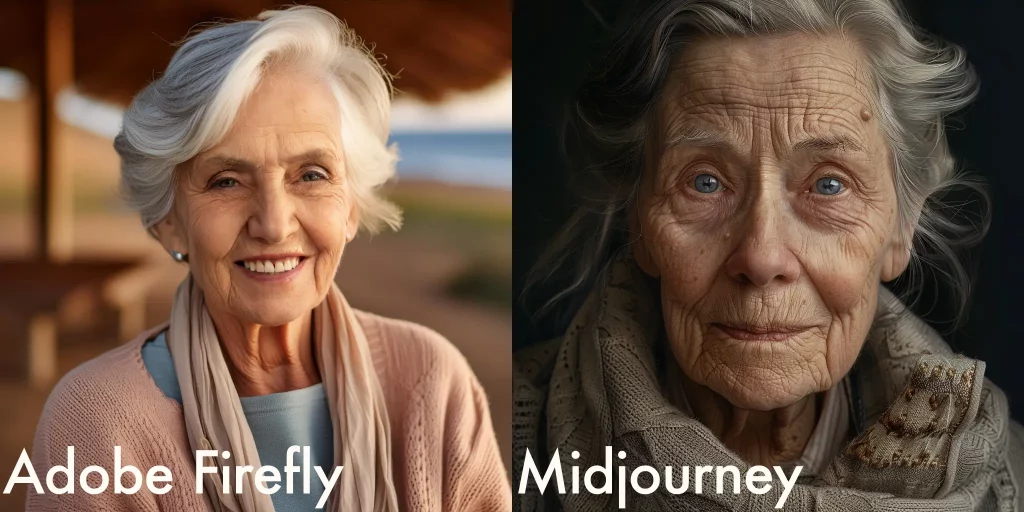
Upon examining the images produced by Adobe Firefly 3 and Midjourney Version 6, I was pleasantly surprised by the quality of both outputs. The Adobe Firefly image depicted a pleasant-looking older woman with a kind face and a subtle smile. The wrinkles on her face were well-defined, adding to the realism of the portrait.
On the other hand, the Midjourney image showcased an elderly woman with a more pronounced network of wrinkles, giving her face a deeply weathered appearance. While the wrinkles were more numerous and prominent compared to the Adobe Firefly image, they did not detract from the overall realism of the portrait.
Both AI models demonstrated a strong capability to generate realistic portraits of elderly individuals, successfully capturing the essence of the prompt. Adobe Firefly’s strength lay in its ability to create a more subdued, natural-looking representation of age, while Midjourney excelled at depicting the intricacies of an aged face with a higher level of detail.
Prompt 2
Prompt: An impressionistic painting of a serene lake surrounded by mountains at sunset
For the second prompt, I challenged the AI models to create an impressionistic painting depicting a tranquil lake encircled by mountains, bathed in the warm hues of a setting sun. This prompt aimed to assess the AI’s ability to generate an artistic representation of a scenic landscape, capturing the ethereal beauty and atmosphere associated with the impressionistic style.
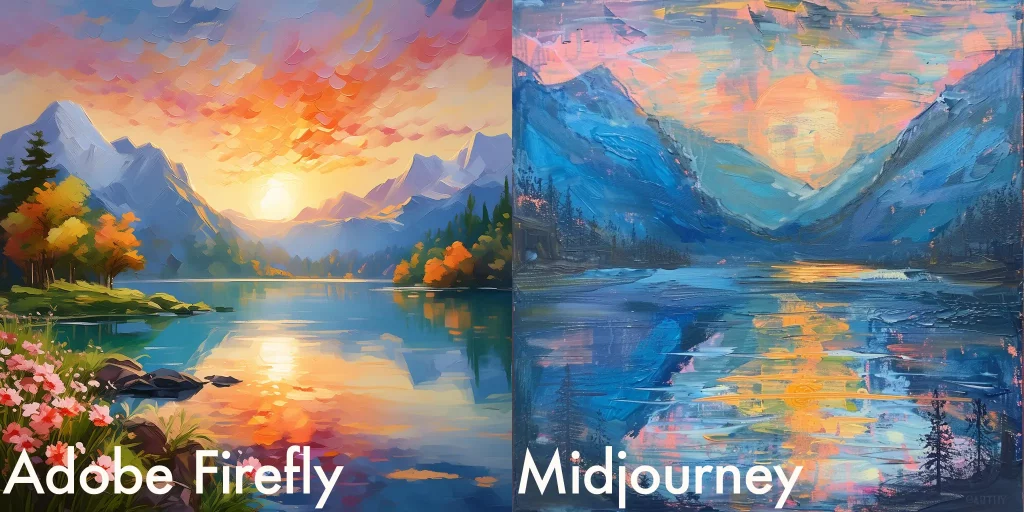
In this case, Adobe Firefly demonstrated a clear superiority over Midjourney. The painting generated by Adobe Firefly was nothing short of breathtaking. The lake was rendered in a soft, dreamlike manner, with gentle brushstrokes blending together to create a sense of serenity and calm.
In contrast, Midjourney’s attempt at an impressionistic lake painting fell somewhat short. While the image did convey the basic elements of the prompt – a lake, mountains, and a sunset sky – it lacked the finesse and artistic flair that made Adobe Firefly’s painting so captivating.
It is worth noting that impressionism is a challenging style to replicate, even for human artists. The ability to convey a sense of atmosphere, light, and emotion through loose, expressive brushwork requires a deep understanding of color, form, and technique.
Prompt 3
Prompt: A character illustration of a brave knight in shining armor, ready for battle
The third prompt in my comparison challenged the AI models to generate a character illustration of a brave knight in shining armor, poised for battle. This prompt aimed to assess the models’ ability to create a visually striking and thematically cohesive depiction of a classic heroic figure.
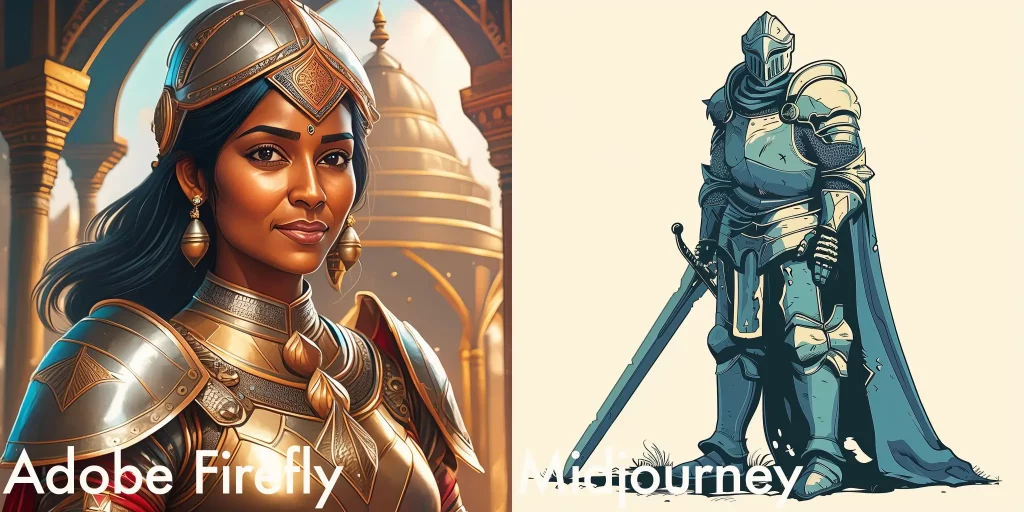
In this instance, Midjourney Version 6 outshone Adobe Firefly 3 by a significant margin. The illustration produced by Midjourney was nothing short of exceptional. The knight stood tall and proud, clad in gleaming armor that reflected the light in a way that suggested both strength and nobility.
Moreover, Midjourney’s knight exuded an air of bravery and determination, with a stance that conveyed readiness for battle. The illustration captured the essence of a heroic figure, embodying the classic tropes of chivalry and valor associated with knights in shining armor.
On the other hand, Adobe Firefly’s attempt at this prompt was surprisingly underwhelming. The illustration it generated fell short of the mark, with a knight that appeared more generic and less visually impressive. The armor lacked the shine and intricacy that made Midjourney’s version so captivating, and the overall composition felt less dynamic and engaging.
Prompt 4
Prompt: A detailed, comic-style artwork of superheroes fighting in a bustling city
In the fourth prompt, I asked the AI models to create a detailed, comic-style artwork depicting superheroes engaged in combat within a bustling city setting. This prompt aimed to test the models’ ability to generate a visually complex and action-packed scene, incorporating the distinctive aesthetics and dynamism associated with comic book art.
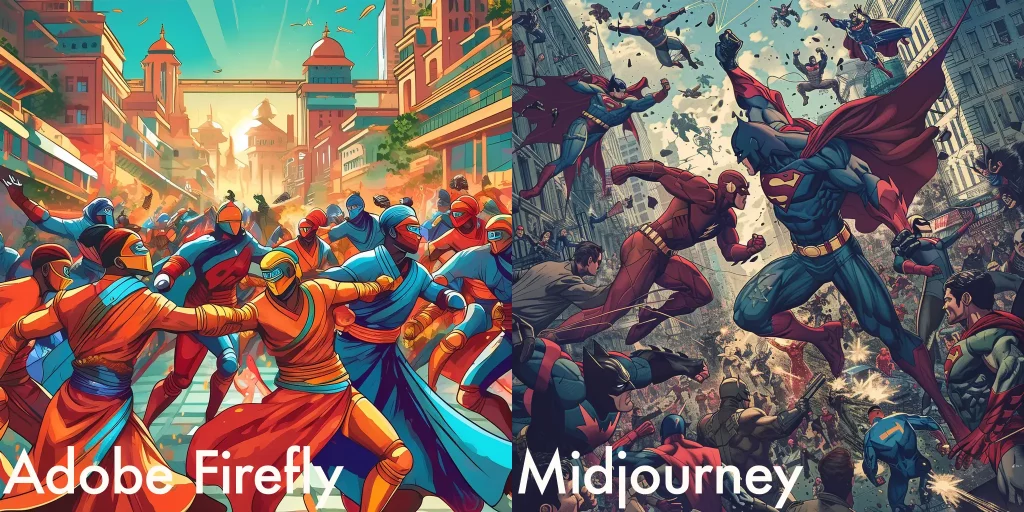
Once again, Midjourney proved its mettle, delivering an artwork that was superior to Adobe Firefly’s attempt. The image generated by Midjourney was a visual feast, packed with intricate details and bursting with energy. The superheroes were rendered in a classic comic book style, with bold lines, vibrant colors, and exaggerated proportions that perfectly captured the larger-than-life nature of these iconic characters.
The action in Midjourney’s artwork was palpable, with the heroes locked in a fierce battle against their foes amidst the towering skyscrapers and bustling streets of the city. The composition was expertly crafted.
In contrast, Adobe Firefly’s interpretation of the prompt left much to be desired. While the image did feature characters that could be identified as superheroes, they lacked the visual impact and dynamism that define the genre. The artwork felt more static and less detailed, failing to capture the excitement and energy inherent in a superhero battle scene.
Prompt 5
Prompt: A photorealistic landscape of a sandy beach with palm trees and crystal-clear water
For the fifth prompt, I challenged the AI models to generate a photorealistic landscape depicting a sandy beach adorned with palm trees and bordered by crystal-clear water.

Both Adobe Firefly 3 and Midjourney Version 6 produced impressive results, generating images that were strikingly realistic and visually appealing. The two AI models demonstrated a strong capacity for rendering the various elements of the scene with a high degree of detail and accuracy.
Adobe Firefly’s image was particularly noteworthy for its realism. The sandy beach looked incredibly lifelike, with a texture and color that seemed to invite the viewer to step right into the scene. The palm trees were rendered with great attention to detail, showcasing the intricate patterns of their trunks and the lush, vibrant green of their fronds.
Midjourney’s image, while also highly realistic, had a slightly different feel. The beach and palm trees were rendered with similar attention to detail, but the overall atmosphere of the scene felt somewhat more stylized, with colors that were a touch more saturated and contrasts that were slightly more pronounced.
Prompt 6
Prompt: A whimsical, fairy-tale inspired illustration of a princess in an enchanted garden
This prompt asked the AI models to create a whimsical, fairy-tale inspired illustration of a princess in an enchanted garden. This prompt aimed to assess the models’ ability to generate a charming, imaginative scene that captures the magical essence of classic fairy tales.
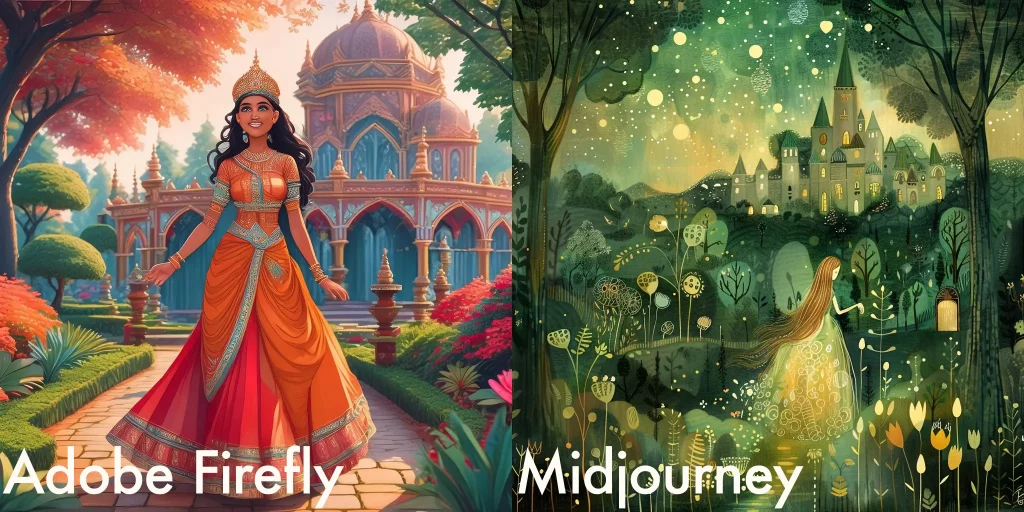
Both Adobe Firefly and Midjourney produced visually appealing illustrations that successfully conveyed the enchanting atmosphere of a fairy-tale setting. The images featured a princess surrounded by lush, vibrant foliage and fantastical elements that transported the viewer to a world of wonder and magic.
While both illustrations were good, Midjourney’s artwork stood out for its exceptional artistic flair and attention to detail. The princess was rendered in a style that felt both classic and fresh, with a gown and delicate features that perfectly embodied the grace and beauty associated with fairy-tale royalty.
Adobe Firefly’s illustration, while still lovely and engaging, felt somewhat less immersive and detailed in comparison. The princess and garden were rendered with skill and care, but the overall composition lacked the same level of depth and intricacy that made Midjourney’s artwork so captivating.
Prompt 7
Prompt: A retro-style, pixel art illustration of an 8-bit video game character on an adventure
I tasked the AI models with creating a retro-style, pixel art illustration depicting an 8-bit video game character embarking on an adventure. This prompt aimed to assess the models’ ability to generate an image that accurately captures the distinctive aesthetics and charm of classic video game graphics.

In this case, Midjourney Version 6 demonstrated a clear superiority over Adobe Firefly 3. The illustration produced by Midjourney was a perfect embodiment of the 8-bit pixel art style, featuring a character and environment that looked as though they had been plucked straight from a beloved retro video game.
The character in Midjourney’s illustration was rendered with crisp, blocky pixels that perfectly captured the iconic look of early video game sprites. Despite the limited palette and resolution, the character exuded personality and charm, with expressive features and a sense of movement that brought them to life on the screen.
In contrast, Adobe Firefly’s attempt at this prompt fell short of the mark. While the image did feature a character and environment, they lacked the authentic pixel art aesthetic that was so integral to the prompt. The character appeared more like a simplified vector graphic than a true 8-bit sprite, lacking the blocky, pixelated charm that defines the style.
Prompt 8
Prompt: A photorealistic image of a rustic, wooden cabin in a snow-covered forest
This prompt in my comparison challenged the AI models to generate a photorealistic image of a rustic, wooden cabin nestled in a snow-covered forest. This prompt aimed to assess the models’ ability to create a convincing, true-to-life representation of a cozy winter scene, capturing the beauty and tranquility of a serene, wooded landscape.
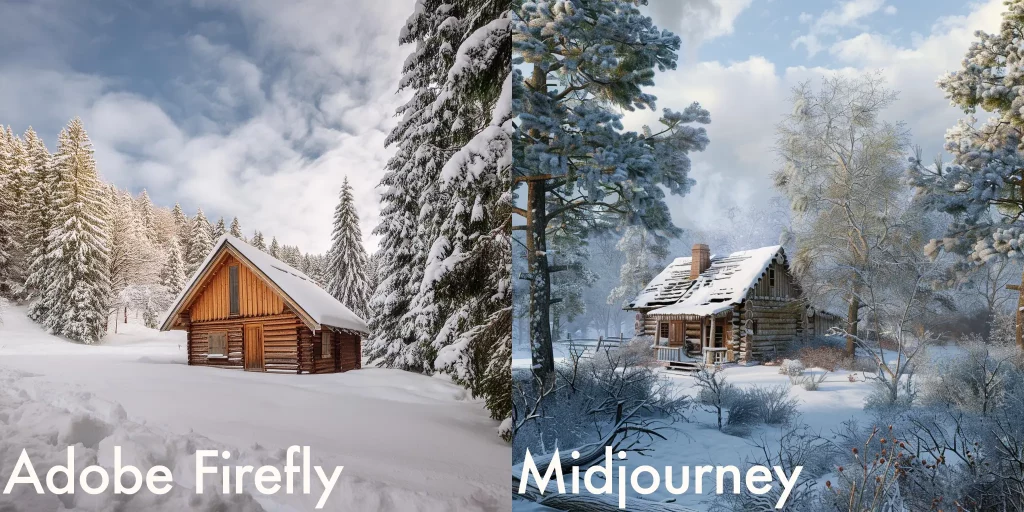
Both Adobe Firefly and Midjourney produced impressive results, generating images that were remarkably lifelike and visually stunning. The two AI models demonstrated a strong capacity for rendering the various elements of the scene with a high degree of detail and realism.
Adobe Firefly’s image was particularly striking, with a level of brightness and clarity that made it stand out. The wooden cabin was rendered with exquisite detail, showcasing the rustic texture of the logs and the charming architectural features that gave it a cozy, inviting feel. The snow that blanketed the surrounding forest was incredibly realistic, with a fluffy, powdery appearance that looked as though it would crunch underfoot.
Midjourney’s image, while also highly realistic and visually appealing, had a slightly different feel. The cabin and surrounding forest were rendered with similar attention to detail, but the overall atmosphere of the scene felt a touch more subdued, with colors that were a bit more muted and a sense of light that was slightly softer and more diffuse.
Prompt 9
Prompt: A dystopian, post-apocalyptic illustration of a ruined city with crumbling buildings and overgrown vegetation
For this prompt, I asked the tools to create a dystopian, post-apocalyptic illustration depicting a ruined city with crumbling buildings and overgrown vegetation. This prompt aimed to assess the models’ ability to generate a visually compelling and atmospheric scene that captures the bleak, unsettling essence of a world gone to ruin.
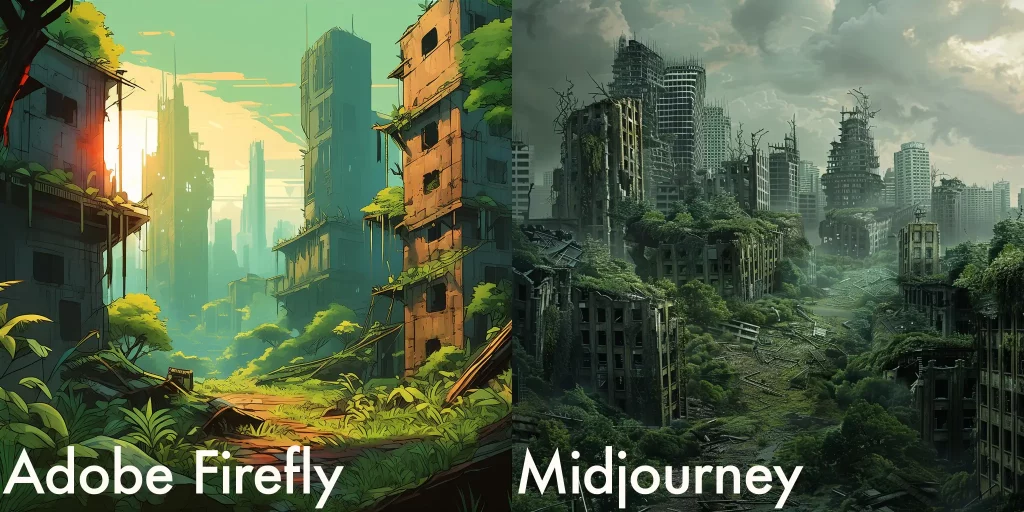
Both Adobe Firefly 3 and Midjourney Version 6 produced illustrations that successfully conveyed the dystopian, post-apocalyptic theme, with cityscapes that were haunting and evocative. The images featured crumbling buildings, shattered windows, and streets choked with debris, painting a vivid picture of a once-thriving metropolis now fallen into decay and abandonment.
While both illustrations were undeniably effective in capturing the mood and atmosphere of the prompt, Adobe Firefly’s image had a slight edge in terms of visual impact and overall composition. The ruined city in Adobe Firefly’s illustration was rendered with a level of detail and intricacy that was truly stunning, from the jagged edges of broken concrete to the twisted remains of rusted metal structures.
The overgrown vegetation in Adobe Firefly’s image was particularly striking, with vines and weeds that snaked through the ruins, reclaiming the once-bustling streets and buildings. Midjourney’s illustration, while also highly effective and atmospheric, felt slightly less immersive and detailed in comparison.
Prompt 10
Prompt: A realistic photo of a busy city street at night, with illuminated signs and car headlights
The tenth prompt in this comparison tasked the AI models with generating a realistic photo of a busy city street at night, complete with illuminated signs and car headlights. This prompt aimed to assess the models’ ability to create a convincing, true-to-life representation of an urban scene, capturing the vibrant energy and atmospheric lighting of a city after dark.
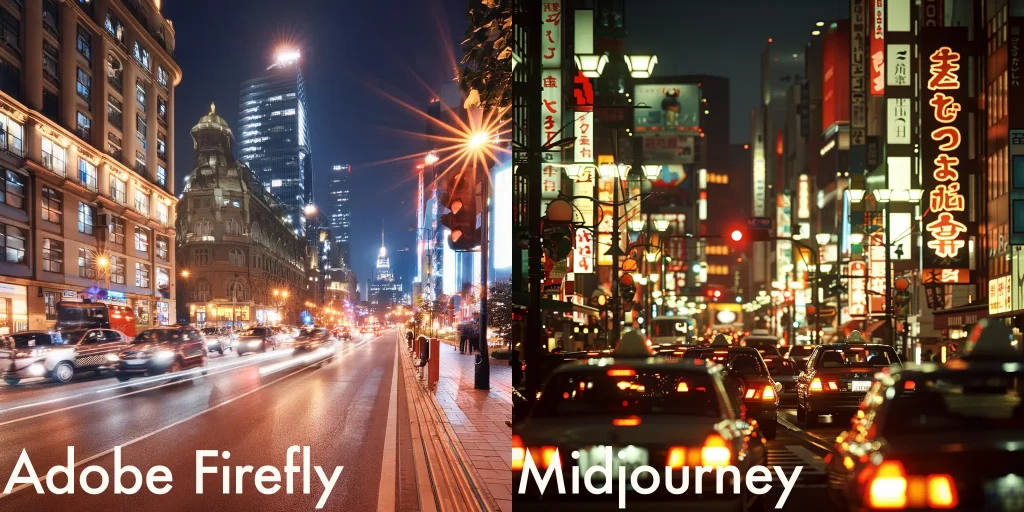
In this case, Midjourney produced an image that was notably superior to Adobe Firefly’s attempt. The photo generated by Midjourney was strikingly realistic, with a level of detail and authenticity that made it feel as though it had been captured by a skilled photographer on the streets of a bustling metropolis.
The city street in Midjourney’s image was alive with activity, with car headlights streaking through the frame and illuminated signs casting a vibrant glow across the scene. The buildings that lined the street were rendered with exquisite detail, from the intricate brickwork to the gleaming windows that reflected the lights of the city.
The overall composition of Midjourney’s photo was expertly crafted, with a perfect balance of light and shadow that created a sense of depth and dimensionality. The image had a cinematic quality, with a moody, atmospheric feel that perfectly captured the essence of a city at night.
In contrast, Adobe Firefly’s attempt at this prompt was less successful. While the image did feature a city street with buildings and lights, it lacked the same level of realism and visual impact that made Midjourney’s photo so compelling.
Prompt 11
Prompt: A fantasy illustration of a majestic dragon soaring over a medieval castle
I challenged the AI models to create a fantasy illustration depicting a majestic dragon soaring over a medieval castle. This prompt aimed to assess the models’ ability to generate a visually stunning and imaginative scene that captures the grandeur and mystery of a classic fantasy setting.
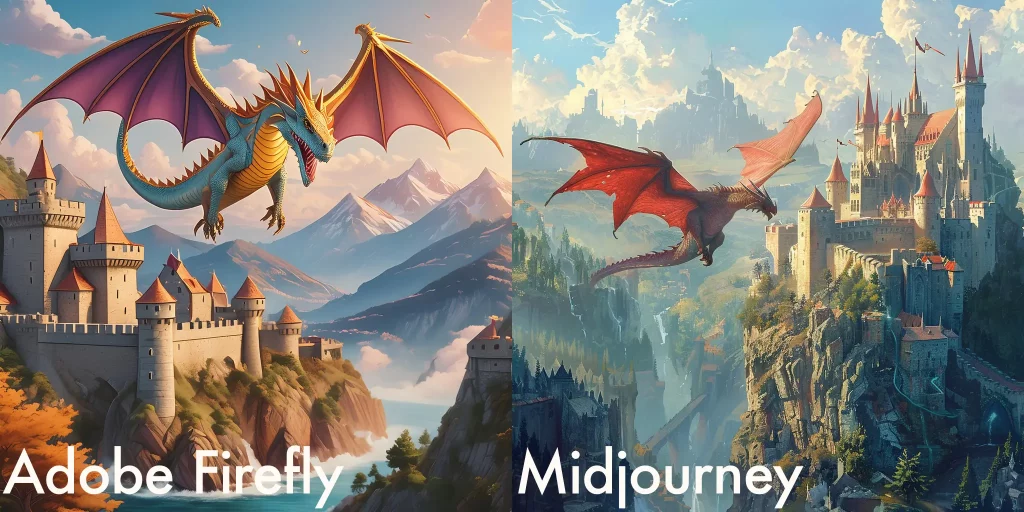
In this instance, Midjourney Version 6 once again demonstrated its prowess, producing an illustration that was far superior to Adobe Firefly 3’s attempt. The image generated by Midjourney was nothing short of breathtaking, with a level of detail, composition, and artistic flair that was truly remarkable.
The dragon in Midjourney’s illustration was a magnificent creature, with scales that gleamed in the light and wings that stretched across the sky. The creature’s pose and expression were expertly crafted, conveying a sense of power, grace, and intelligence that perfectly embodied the majesty of a fantasy dragon.
The overall composition of Midjourney’s illustration was masterful, with a perfect balance of elements that drew the eye and captured the imagination. The use of color and light was particularly striking, with a warm, golden glow that suffused the scene and created an atmosphere of magic and wonder.
In stark contrast, Adobe Firefly’s attempt at this prompt was a profound disappointment. The dragon in Adobe Firefly’s image was poorly rendered, with a simplistic, cartoonish appearance that lacked any sense of majesty or power. The creature’s proportions were off, and its pose and expression were lifeless and unconvincing.
Prompt 12
Prompt: A realistic still-life painting of a vase filled with sunflowers on a wooden table
I asked the AI models to generate a realistic still-life painting depicting a vase filled with sunflowers on a wooden table. This prompt aimed to assess the models’ ability to create a convincing, true-to-life representation of a classic artistic subject, capturing the beauty and vibrancy of the flowers and the richness of the surrounding textures.
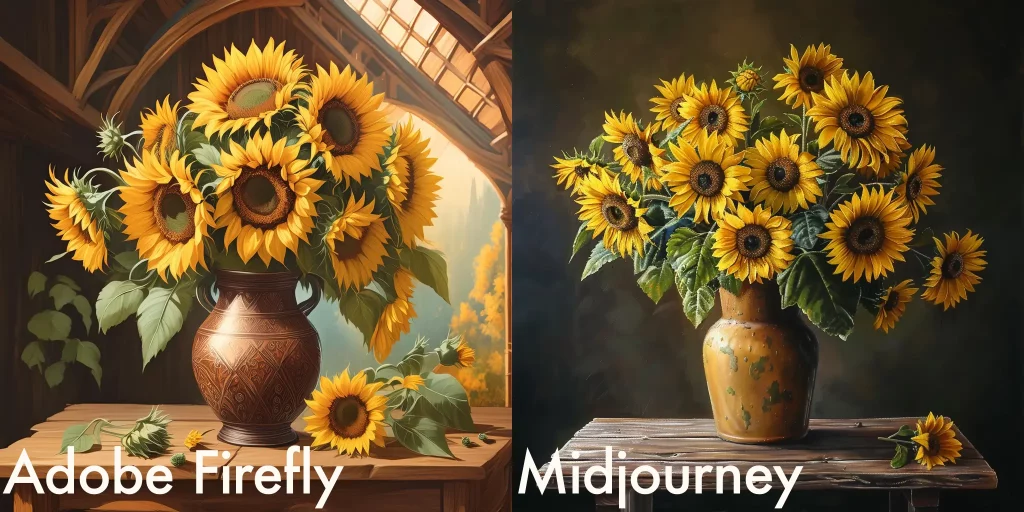
Both tools produced impressive results, generating paintings that were remarkably lifelike and visually stunning. The two AI models demonstrated a strong capacity for rendering the various elements of the scene with a high degree of detail and realism.
Adobe Firefly’s painting was particularly striking, with a level of depth and dimensionality that made it stand out. The sunflowers in the vase were rendered with exquisite detail, showcasing the intricate petals, the subtle variations in color, and the delicate interplay of light and shadow that brought the flowers to life.
The vase itself was equally impressive, with a realistic sense of form and texture that perfectly captured the look and feel of ceramic. The wooden table on which the vase was placed was rendered with a level of detail that was truly astonishing, from the intricate grain patterns to the subtle variations in color and shading.
Midjourney’s painting, while also highly realistic and visually appealing, had a slightly different feel. The sunflowers and vase were rendered with similar attention to detail, but the overall atmosphere of the scene felt a touch more subdued, with colors that were a bit softer and a sense of light that was slightly more diffuse.
Prompt 13
Prompt: A minimalist, geometric abstract art piece with bold colors and clean lines
I tasked the AI models with creating a minimalist, geometric abstract art piece featuring bold colors and clean lines. This prompt aimed to assess the models’ ability to generate a visually striking and compositionally balanced image that captures the essence of the minimalist aesthetic.
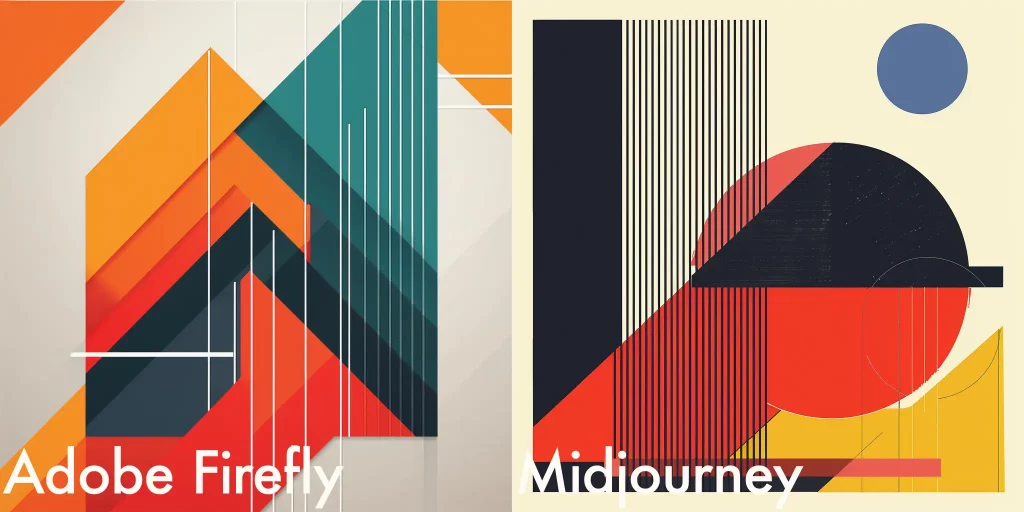
Both tools produced art pieces that successfully embodied the key elements of the prompt, with simple geometric shapes, vibrant colors, and a clean, uncluttered composition. The two AI models demonstrated a strong grasp of the principles of minimalist design, creating images that were both visually impactful and conceptually intriguing.
Ultimately, the choice between the two art pieces would come down to personal preference and the specific mood or atmosphere that one hopes to convey. If the goal is to create an image with a bold, energetic, and slightly more structured feel, Adobe Firefly’s output may be the preferred choice. Its use of primary colors and precise, geometric shapes creates a sense of vibrancy and visual impact that is hard to ignore.
Prompt 14
Prompt: A realistic people photo of a group of friends enjoying a picnic in a park
The final prompt in our comparison challenged the AI models to generate a realistic photo depicting a group of friends enjoying a picnic in a park. This prompt aimed to assess the models’ ability to create a convincing, true-to-life representation of a common social scenario, capturing the joy, camaraderie, and natural interactions of a group of people in an outdoor setting.
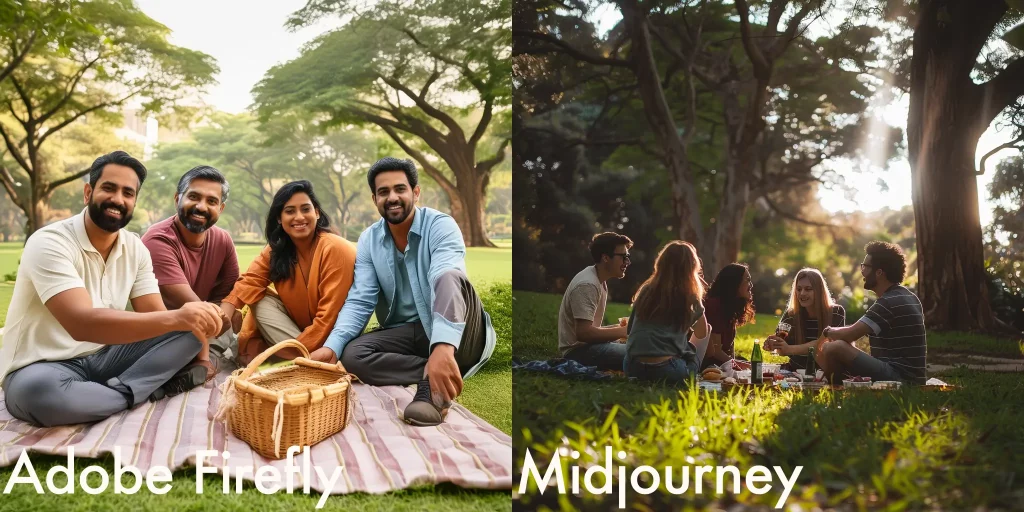
Both Adobe Firefly 3 and Midjourney Version 6 produced photos that attempted to convey the essence of the prompt, with groups of people gathered together on picnic blankets, surrounded by the greenery of a park. However, upon closer inspection, it became clear that both images had certain flaws and limitations that detracted from their overall realism and effectiveness.
Adobe Firefly’s photo featured a group of friends sitting on a picnic blanket. While the general composition and setting were appropriate, the people in the image had a slightly artificial or posed quality, with expressions and body language that felt somewhat stiff and unnatural.
Midjourney’s photo, while also depicting a group of friends enjoying a picnic, had a slightly more natural and candid feel. The people in the image appeared more relaxed and engaged with one another, with expressions and gestures that felt more authentic and spontaneous.
In comparing the two photos, it becomes clear that generating realistic images of people in complex social scenarios remains a significant challenge for AI models. While both Adobe Firefly 3 and Midjourney Version 6 were able to capture the basic elements of the prompt, neither was able to fully replicate the nuances and subtleties of human interaction and emotion that make a photo truly convincing.
Throughout this in-depth comparison of Adobe Firefly 3 and Midjourney Version 6, I have explored the capabilities and limitations of these two cutting-edge AI image generation models across a wide range of prompts and scenarios.
From realistic portraits and landscapes to whimsical illustrations and abstract art pieces, we have seen both models demonstrate remarkable abilities to generate visually striking and emotionally resonant images.
However, we have also observed that each model has its own unique strengths and weaknesses, excelling in certain areas while struggling in others. Adobe Firefly 3, for example, demonstrated a particular aptitude for generating realistic still-life paintings and photorealistic landscapes, capturing the subtle nuances of light, color, and texture with impressive accuracy and detail.
On the other hand, Midjourney Version 6 showed a greater proficiency in creating character illustrations, comic-style artwork, and fantasy-inspired scenes, bringing a level of artistic flair and imaginative depth to its generated images.
Looking forward, it is exciting to consider the possibilities that lie ahead for AI image generation. As these models become more sophisticated and refined, they may open up new avenues for creative expression, collaboration, and innovation across a wide range of fields, from graphic design and advertising to film and video game production.
